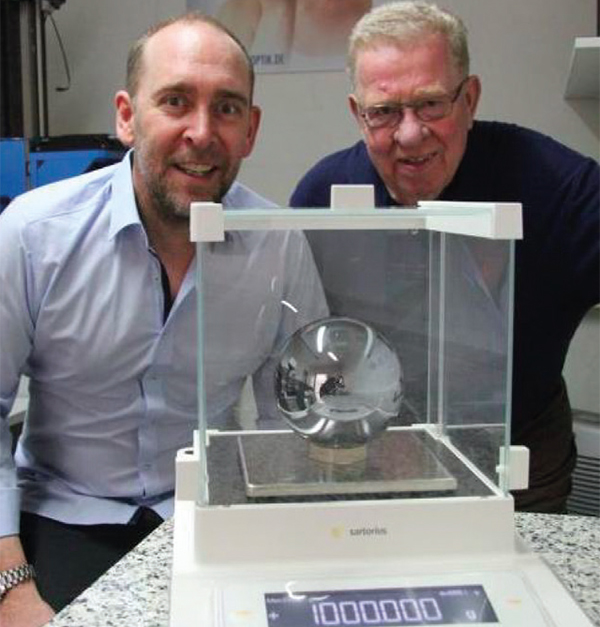The new standard kilogram
A JOINT RESEARCH PROJECT FROM PTB AND HAUSER
In 2015 one of the biggest challenges in the history of HAUSER OPTIK and also an extremely exciting project started: The PHYSICALLY - TECHNICAL FEDERAL INSTITUTE (PTB), Braunschweig, has been developing the new Standard Kilogram, which shall replace the actual one, stored in Paris since 1889. The demands on the new Standard Kilogram, which will be manufactured from pure silicon, are extremely challenging, especially concerning the roundness (< 20nm) and the surface roughness (Ra < 0,1nm). HAUSER OPTIK is the only partner from PTB worldwide, which is involved in this project concerning the production of this silicon sphere.
These silicon spheres are to be sourced exclusively by our project partner, HÄFNER Gewichte GmbH, located in Oberrot, Germany.
www.haefner.de


A current report from the WNZ (28.04.2018)
The prototype kilo is the standard for all masses. The 129-year-old „international kilogram prototype“ hast lost some weight recently, however. The world of meteorologists is in uproar. A new definition for the kilogram was needed. Hauser Optik plays an important role in this.
Along with the second, metre, ampere, kelvin, mol (material amount) and candela (luminous intensity), the kilogram is one of seven basic units that make the world consistently measurable.
As a mass unit, the kilogram can be found anywhere: in research and industry, in the supermarket and on the scale in your bathroom at home. Since 1889, it has been defined by a 3.9 centimetres large cylinder of platinum and iridium, stored well-protected under glass covers in a safe of the Paris „Bureau International des Poids et Mesures“ (BIPM) – in best company of the prototype metre, which has, however, already been retired. The prototype kilo has lost some weight. Roughly 50 micrograms seem to have vanished without a trace. This was noticed in comparison measurements with several copies.
A loss of 50 microgram may not be a huge deal in everyday life, but in industries that rely on precision, even the 50-millionth part of a gram will make a difference. Most likely, it was lost by abrasion when cleaning or due to gassing out of hydrogen. The shrinking 129-year-old metal cylinder is now about to be replaced by a ball made of silicon-28, with a diameter of 9.4 centimetres. Each of these balls costs at least a million Euro. In November, the kilogram unit is to be defined on the Paris general conference for measures and weights. The silicon ball with its as-yet unachieved accuracy of form is the favourite of the Physically-Technical Federal Institute (Physikalisch-Technische Bundesanstalt; PTB) for the kilogram. Its material and form represent long-term stability, easy handling and cleaning.
Hauser Optik has been involved in the research project as a partner for three years. The researchers from Braunschweig first noticed the company from Burgsolms because of the optical high-precision balls produced by it, which enjoy an excellent international reputation.
Since then, the family-owned company has produced high-precision balls for the Federal Institute as samples and prototypes for the scientists to experiment with. For managing directors Wolfgang and Stefan Hauser, cooperation with the PTB is „an honour“ and „a very, very good reference“ for the company with its currently 35 employees. The Hauser family is fully aware that such an important order is a oncein- a-lifetime event. Calculation of the kilogram and its manifestation in silicon is a complicated matter that has kept researchers busy for decades and that repeatedly brought them to the limits of what was physically measurable. A single silicon ball of one kilogram has 1000 times more atoms than there are stars in the universe. The researchers have now found a method to calculate the number of atoms using the ball volume. The weight of every single atom can be derived from this and, vice versa, the number of atoms needed for one kilo can be calculated.
This specifies the kilogram once and for all. The balls must be shaped perfectly to a few nanometres. Stefan Hauser says that the pore size is as little as 0.1 nanometre, making the surface virtually sealed. Nothing can adhere to it and falsify the weight. The PTB shared its highly specialised production method with J. Hauser GmbH & Co. KG as well in the scope of their joint research project. The company from Burgsolms will be able to produce much more cost-efficient balls of natural silicon in future and market them globally. There are many potential customers, e.g. in the industry and in the metrology institutes around the world. With the exception of PTB, Hauser Optik is the only one with the technology „to produce by far the roundest object of its kind anywhere,“ the Federal Institute certifies.
The prototypes of the new kilogram will, however, not be produced in Central Hesse, but by the PTB. It is expected that they will replace the 129-year-old prototype kilo after the Paris Conference in November. The metal cylinder will be history then, and silicon balls will be put in safe storage instead.All masses will be based on these for the next decades – and who knows for how long. All scales – including those in the supermarket as well as those in your bathroom – will be calibrated to the prototype at some point, even if there may be some detours. The World Meteorology Day on 20 May 2019 is to be the key date for the new definition of the kilogram, but also those of the mol, ampere and kelvin, to formally enter into effect based on selected natural constants. It will be „great history“ for the people from Burgsolms to hear the name of Hauser in connection with the new kilogram thereafter.
Author: Steffen Gross, WNZ



